DODGE RAM 2001 Service Repair Manual
Manufacturer: DODGE, Model Year: 2001, Model line: RAM, Model: DODGE RAM 2001Pages: 2889, PDF Size: 68.07 MB
Page 1721 of 2889
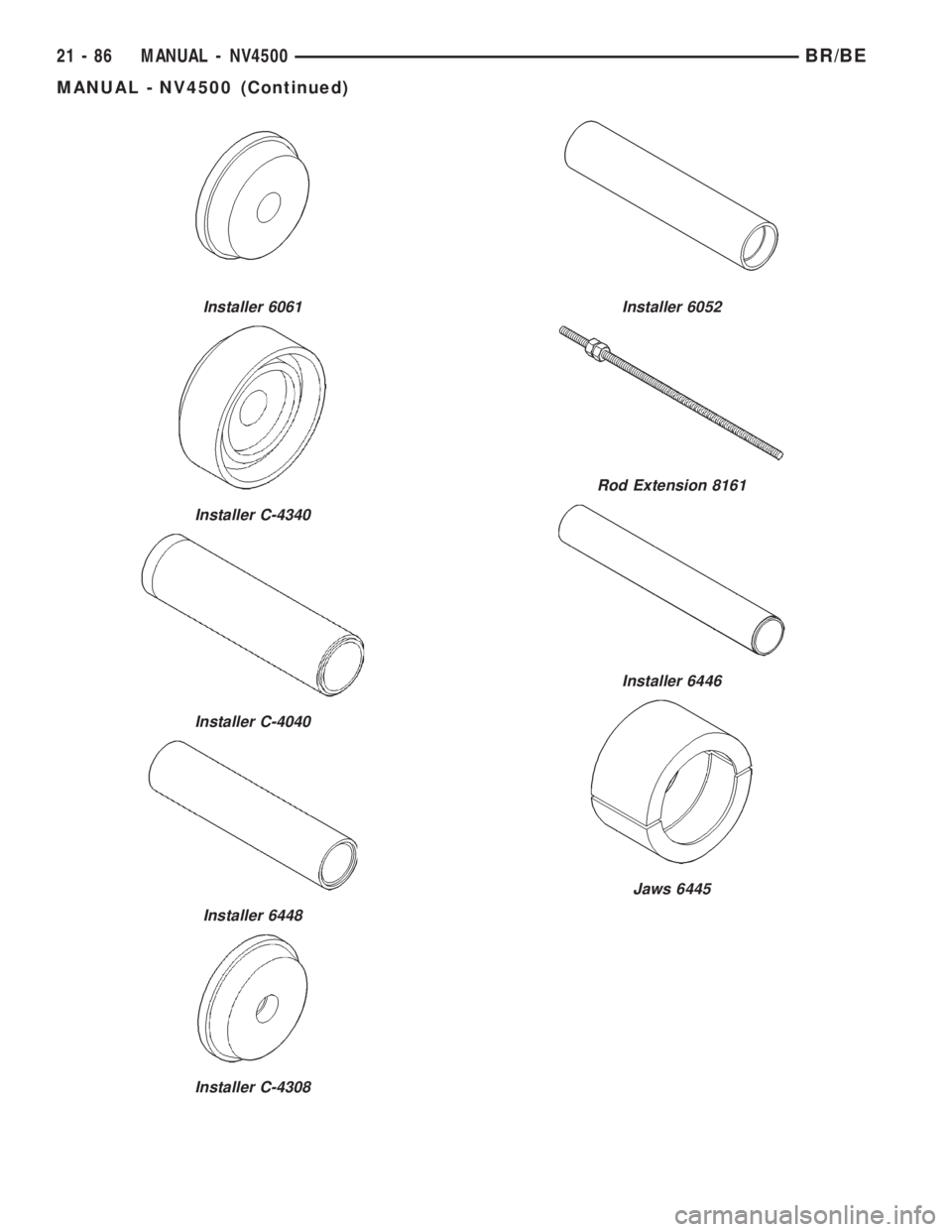
Installer 6061
Installer C-4340
Installer C-4040
Installer 6448
Installer C-4308
Installer 6052
Rod Extension 8161
Installer 6446
Jaws 6445
21 - 86 MANUAL - NV4500BR/BE
MANUAL - NV4500 (Continued)
Page 1722 of 2889
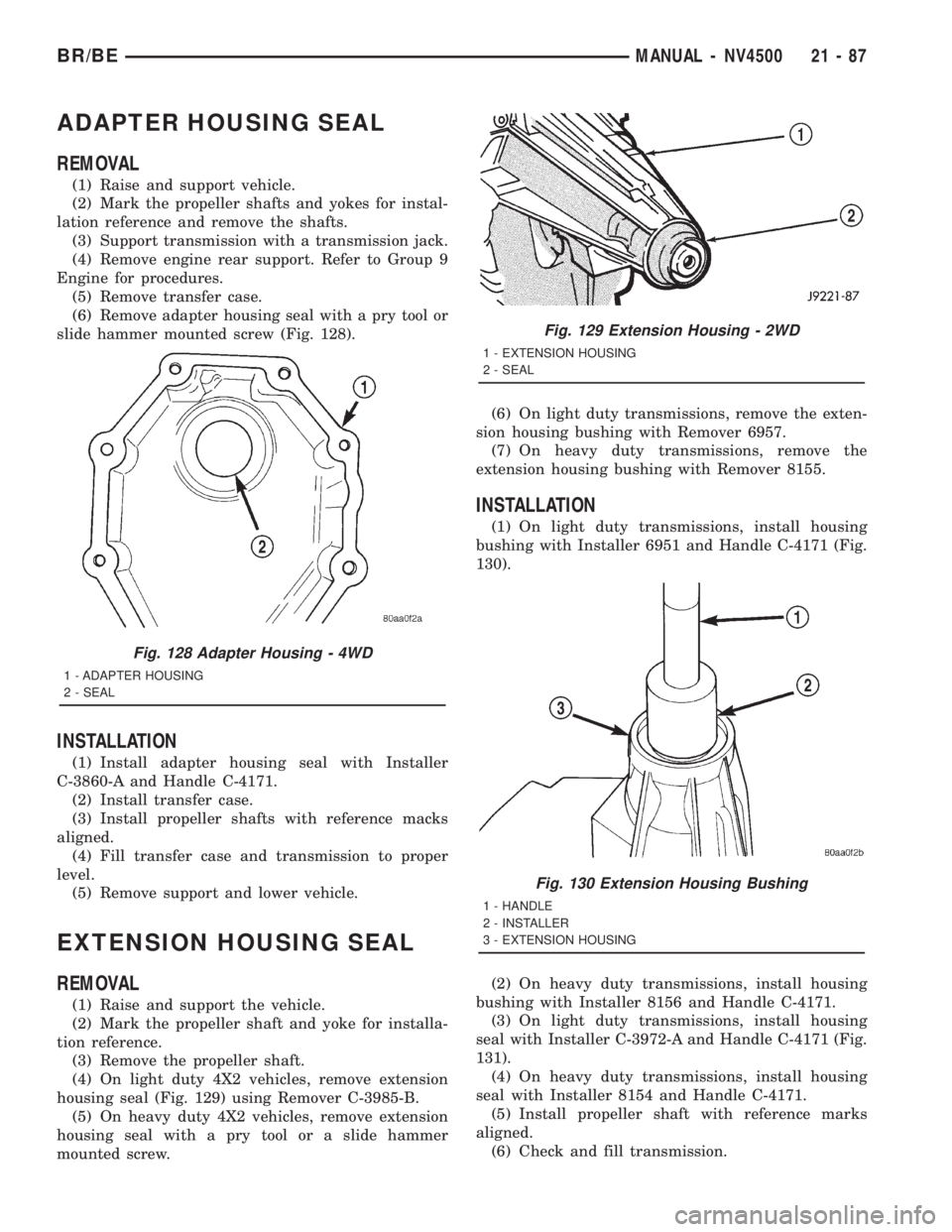
ADAPTER HOUSING SEAL
REMOVAL
(1) Raise and support vehicle.
(2) Mark the propeller shafts and yokes for instal-
lation reference and remove the shafts.
(3) Support transmission with a transmission jack.
(4) Remove engine rear support. Refer to Group 9
Engine for procedures.
(5) Remove transfer case.
(6) Remove adapter housing seal with a pry tool or
slide hammer mounted screw (Fig. 128).
INSTALLATION
(1) Install adapter housing seal with Installer
C-3860-A and Handle C-4171.
(2) Install transfer case.
(3) Install propeller shafts with reference macks
aligned.
(4) Fill transfer case and transmission to proper
level.
(5) Remove support and lower vehicle.
EXTENSION HOUSING SEAL
REMOVAL
(1) Raise and support the vehicle.
(2) Mark the propeller shaft and yoke for installa-
tion reference.
(3) Remove the propeller shaft.
(4) On light duty 4X2 vehicles, remove extension
housing seal (Fig. 129) using Remover C-3985-B.
(5) On heavy duty 4X2 vehicles, remove extension
housing seal with a pry tool or a slide hammer
mounted screw.(6) On light duty transmissions, remove the exten-
sion housing bushing with Remover 6957.
(7) On heavy duty transmissions, remove the
extension housing bushing with Remover 8155.
INSTALLATION
(1) On light duty transmissions, install housing
bushing with Installer 6951 and Handle C-4171 (Fig.
130).
(2) On heavy duty transmissions, install housing
bushing with Installer 8156 and Handle C-4171.
(3) On light duty transmissions, install housing
seal with Installer C-3972-A and Handle C-4171 (Fig.
131).
(4) On heavy duty transmissions, install housing
seal with Installer 8154 and Handle C-4171.
(5) Install propeller shaft with reference marks
aligned.
(6) Check and fill transmission.
Fig. 128 Adapter Housing - 4WD
1 - ADAPTER HOUSING
2 - SEAL
Fig. 129 Extension Housing - 2WD
1 - EXTENSION HOUSING
2 - SEAL
Fig. 130 Extension Housing Bushing
1 - HANDLE
2 - INSTALLER
3 - EXTENSION HOUSING
BR/BEMANUAL - NV4500 21 - 87
Page 1723 of 2889
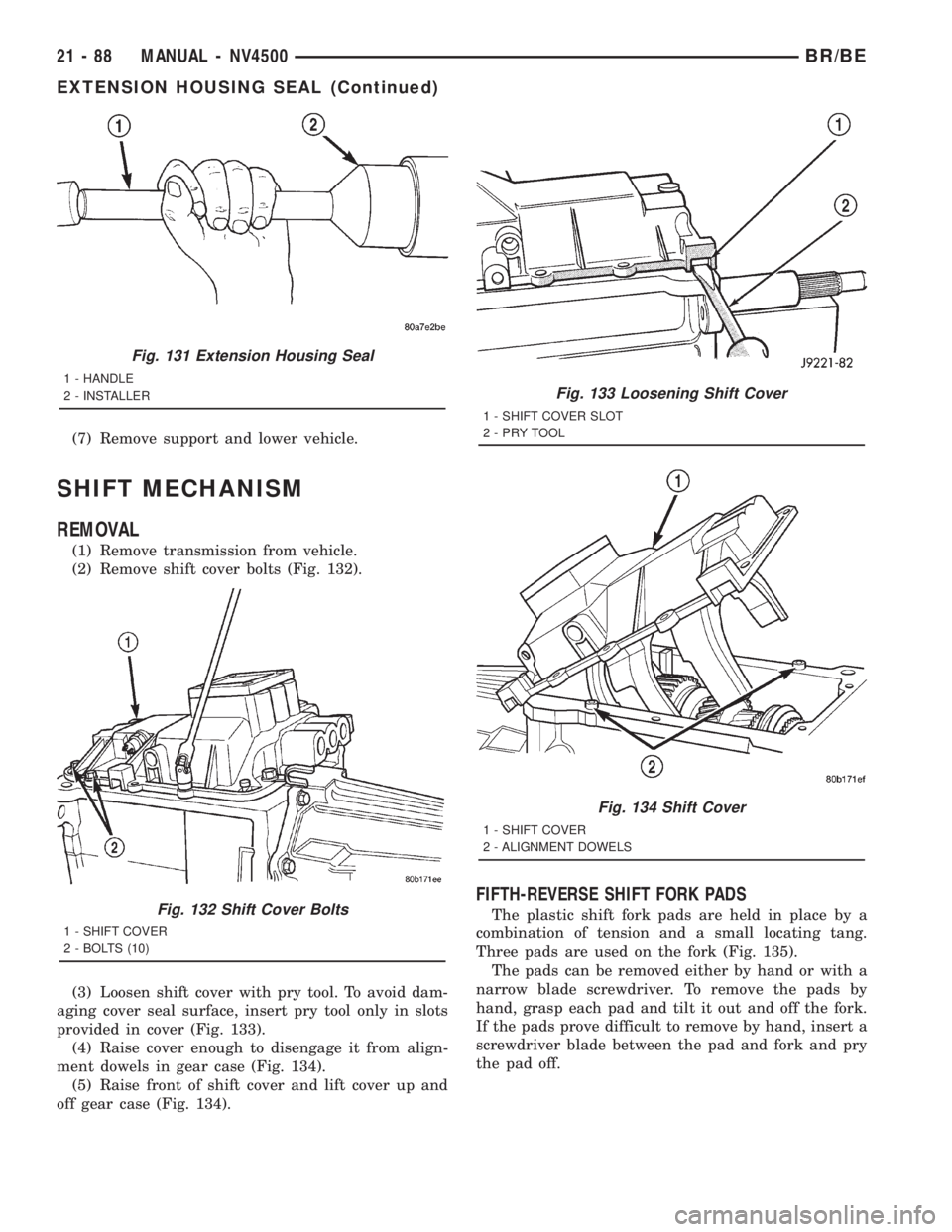
(7) Remove support and lower vehicle.
SHIFT MECHANISM
REMOVAL
(1) Remove transmission from vehicle.
(2) Remove shift cover bolts (Fig. 132).
(3) Loosen shift cover with pry tool. To avoid dam-
aging cover seal surface, insert pry tool only in slots
provided in cover (Fig. 133).
(4) Raise cover enough to disengage it from align-
ment dowels in gear case (Fig. 134).
(5) Raise front of shift cover and lift cover up and
off gear case (Fig. 134).
FIFTH-REVERSE SHIFT FORK PADS
The plastic shift fork pads are held in place by a
combination of tension and a small locating tang.
Three pads are used on the fork (Fig. 135).
The pads can be removed either by hand or with a
narrow blade screwdriver. To remove the pads by
hand, grasp each pad and tilt it out and off the fork.
If the pads prove difficult to remove by hand, insert a
screwdriver blade between the pad and fork and pry
the pad off.
Fig. 131 Extension Housing Seal
1 - HANDLE
2 - INSTALLER
Fig. 132 Shift Cover Bolts
1 - SHIFT COVER
2 - BOLTS (10)
Fig. 133 Loosening Shift Cover
1 - SHIFT COVER SLOT
2-PRYTOOL
Fig. 134 Shift Cover
1 - SHIFT COVER
2 - ALIGNMENT DOWELS
21 - 88 MANUAL - NV4500BR/BE
EXTENSION HOUSING SEAL (Continued)
Page 1724 of 2889
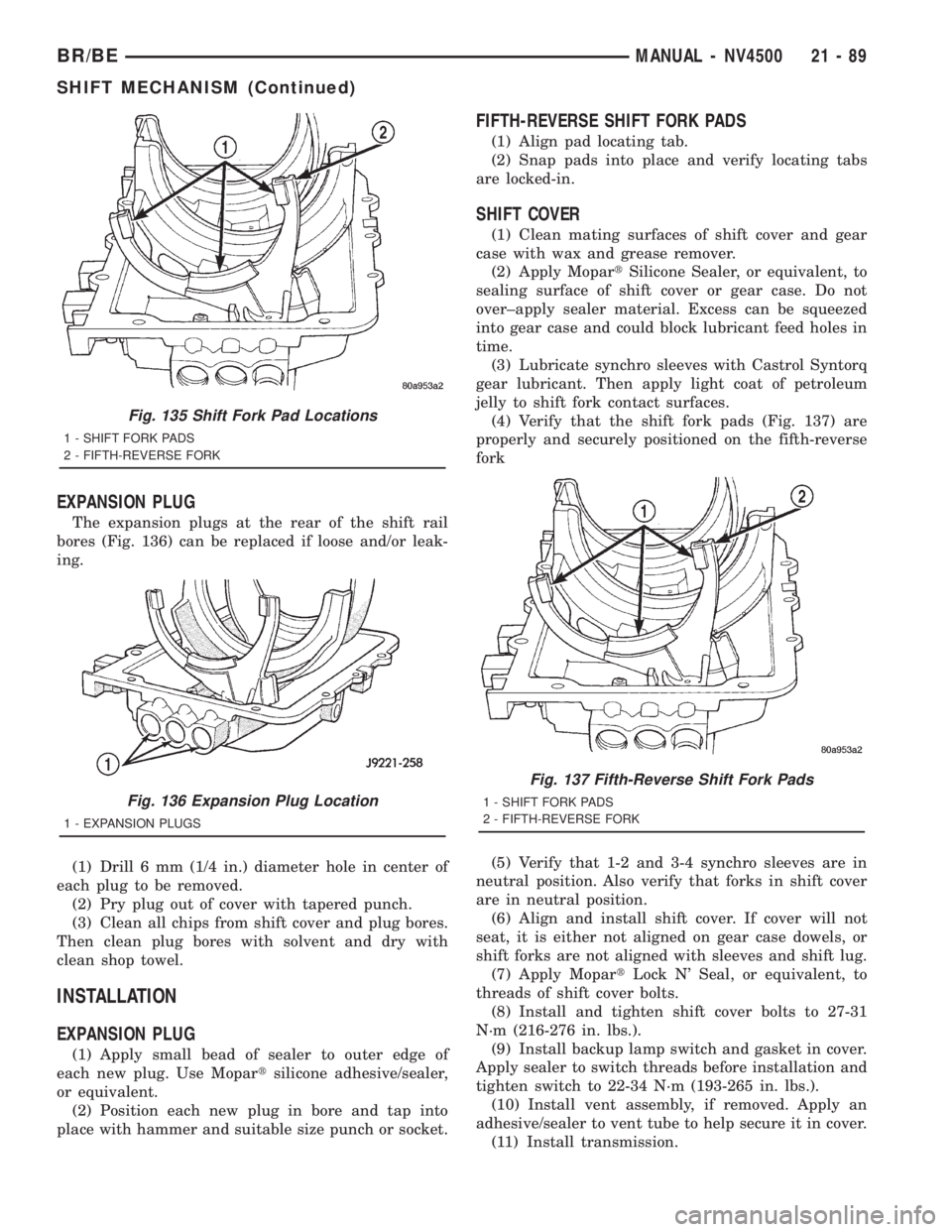
EXPANSION PLUG
The expansion plugs at the rear of the shift rail
bores (Fig. 136) can be replaced if loose and/or leak-
ing.
(1) Drill 6 mm (1/4 in.) diameter hole in center of
each plug to be removed.
(2) Pry plug out of cover with tapered punch.
(3) Clean all chips from shift cover and plug bores.
Then clean plug bores with solvent and dry with
clean shop towel.
INSTALLATION
EXPANSION PLUG
(1) Apply small bead of sealer to outer edge of
each new plug. Use Mopartsilicone adhesive/sealer,
or equivalent.
(2) Position each new plug in bore and tap into
place with hammer and suitable size punch or socket.
FIFTH-REVERSE SHIFT FORK PADS
(1) Align pad locating tab.
(2) Snap pads into place and verify locating tabs
are locked-in.
SHIFT COVER
(1) Clean mating surfaces of shift cover and gear
case with wax and grease remover.
(2) Apply MopartSilicone Sealer, or equivalent, to
sealing surface of shift cover or gear case. Do not
over±apply sealer material. Excess can be squeezed
into gear case and could block lubricant feed holes in
time.
(3) Lubricate synchro sleeves with Castrol Syntorq
gear lubricant. Then apply light coat of petroleum
jelly to shift fork contact surfaces.
(4) Verify that the shift fork pads (Fig. 137) are
properly and securely positioned on the fifth-reverse
fork
(5) Verify that 1-2 and 3-4 synchro sleeves are in
neutral position. Also verify that forks in shift cover
are in neutral position.
(6) Align and install shift cover. If cover will not
seat, it is either not aligned on gear case dowels, or
shift forks are not aligned with sleeves and shift lug.
(7) Apply MopartLock N' Seal, or equivalent, to
threads of shift cover bolts.
(8) Install and tighten shift cover bolts to 27-31
N´m (216-276 in. lbs.).
(9) Install backup lamp switch and gasket in cover.
Apply sealer to switch threads before installation and
tighten switch to 22-34 N´m (193-265 in. lbs.).
(10) Install vent assembly, if removed. Apply an
adhesive/sealer to vent tube to help secure it in cover.
(11) Install transmission.
Fig. 135 Shift Fork Pad Locations
1 - SHIFT FORK PADS
2 - FIFTH-REVERSE FORK
Fig. 136 Expansion Plug Location
1 - EXPANSION PLUGS
Fig. 137 Fifth-Reverse Shift Fork Pads
1 - SHIFT FORK PADS
2 - FIFTH-REVERSE FORK
BR/BEMANUAL - NV4500 21 - 89
SHIFT MECHANISM (Continued)
Page 1725 of 2889
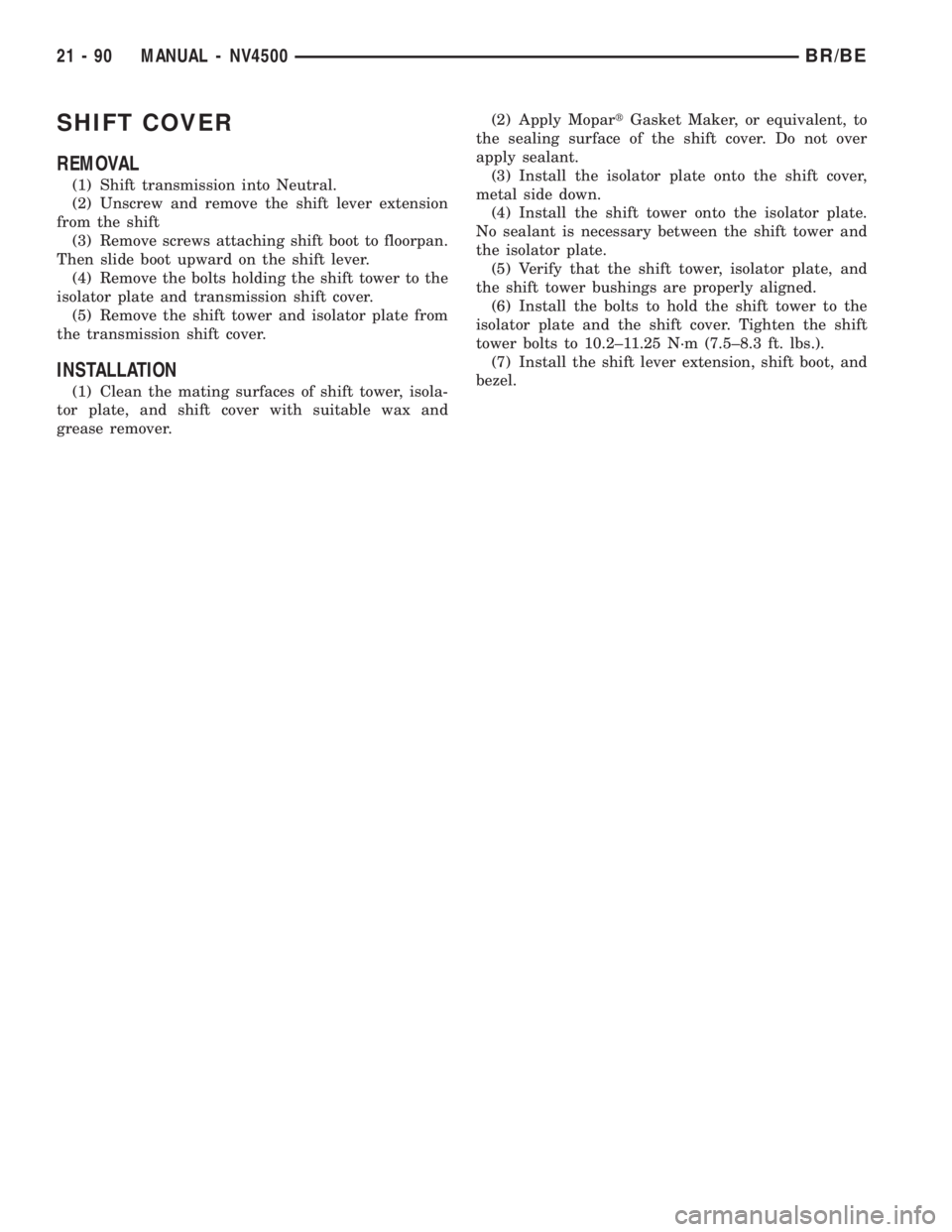
SHIFT COVER
REMOVAL
(1) Shift transmission into Neutral.
(2) Unscrew and remove the shift lever extension
from the shift
(3) Remove screws attaching shift boot to floorpan.
Then slide boot upward on the shift lever.
(4) Remove the bolts holding the shift tower to the
isolator plate and transmission shift cover.
(5) Remove the shift tower and isolator plate from
the transmission shift cover.
INSTALLATION
(1) Clean the mating surfaces of shift tower, isola-
tor plate, and shift cover with suitable wax and
grease remover.(2) Apply MopartGasket Maker, or equivalent, to
the sealing surface of the shift cover. Do not over
apply sealant.
(3) Install the isolator plate onto the shift cover,
metal side down.
(4) Install the shift tower onto the isolator plate.
No sealant is necessary between the shift tower and
the isolator plate.
(5) Verify that the shift tower, isolator plate, and
the shift tower bushings are properly aligned.
(6) Install the bolts to hold the shift tower to the
isolator plate and the shift cover. Tighten the shift
tower bolts to 10.2±11.25 N´m (7.5±8.3 ft. lbs.).
(7) Install the shift lever extension, shift boot, and
bezel.
21 - 90 MANUAL - NV4500BR/BE
Page 1726 of 2889
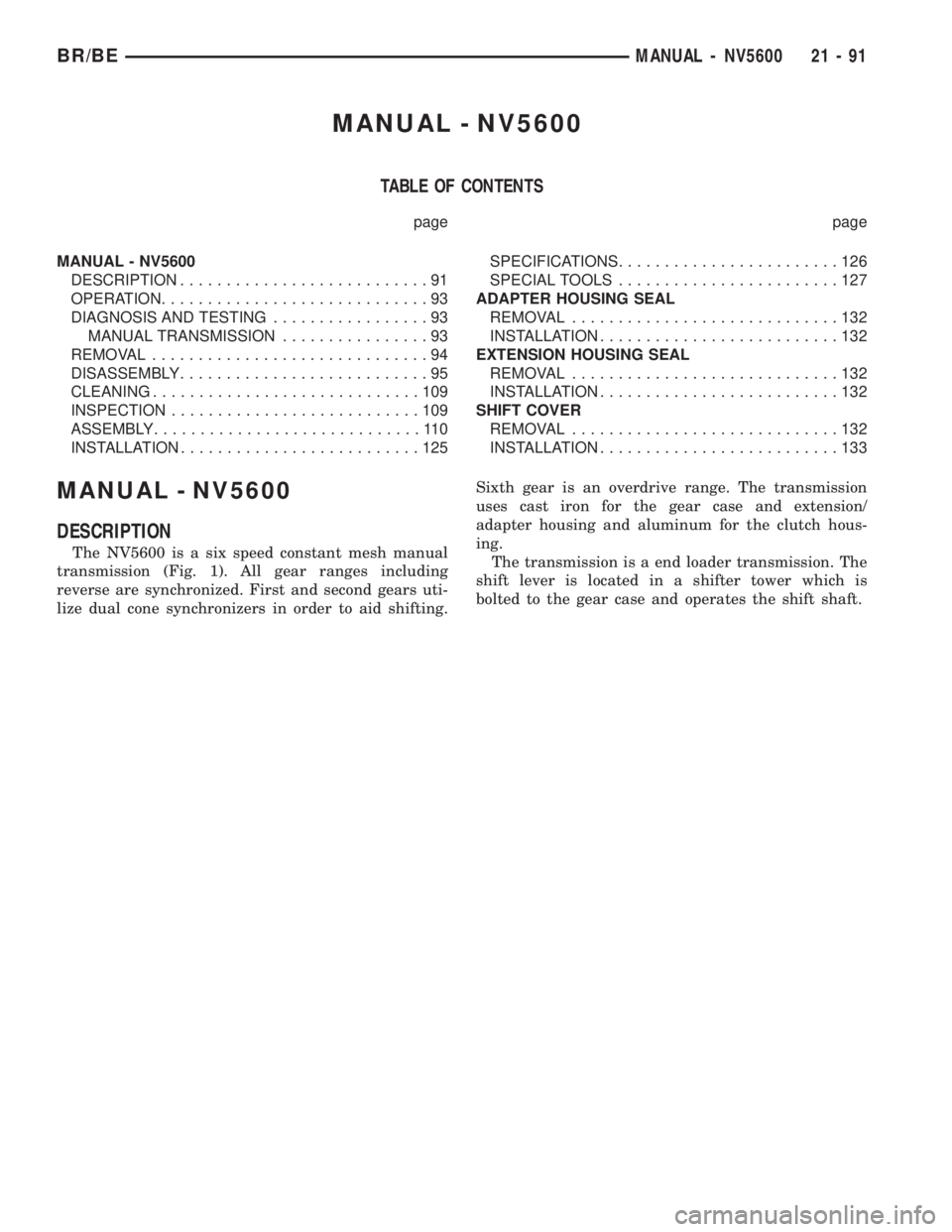
MANUAL - NV5600
TABLE OF CONTENTS
page page
MANUAL - NV5600
DESCRIPTION...........................91
OPERATION.............................93
DIAGNOSIS AND TESTING.................93
MANUAL TRANSMISSION................93
REMOVAL..............................94
DISASSEMBLY...........................95
CLEANING.............................109
INSPECTION...........................109
ASSEMBLY.............................110
INSTALLATION..........................125SPECIFICATIONS........................126
SPECIAL TOOLS........................127
ADAPTER HOUSING SEAL
REMOVAL.............................132
INSTALLATION..........................132
EXTENSION HOUSING SEAL
REMOVAL.............................132
INSTALLATION..........................132
SHIFT COVER
REMOVAL.............................132
INSTALLATION..........................133
MANUAL - NV5600
DESCRIPTION
The NV5600 is a six speed constant mesh manual
transmission (Fig. 1). All gear ranges including
reverse are synchronized. First and second gears uti-
lize dual cone synchronizers in order to aid shifting.Sixth gear is an overdrive range. The transmission
uses cast iron for the gear case and extension/
adapter housing and aluminum for the clutch hous-
ing.
The transmission is a end loader transmission. The
shift lever is located in a shifter tower which is
bolted to the gear case and operates the shift shaft.
BR/BEMANUAL - NV5600 21 - 91
Page 1727 of 2889
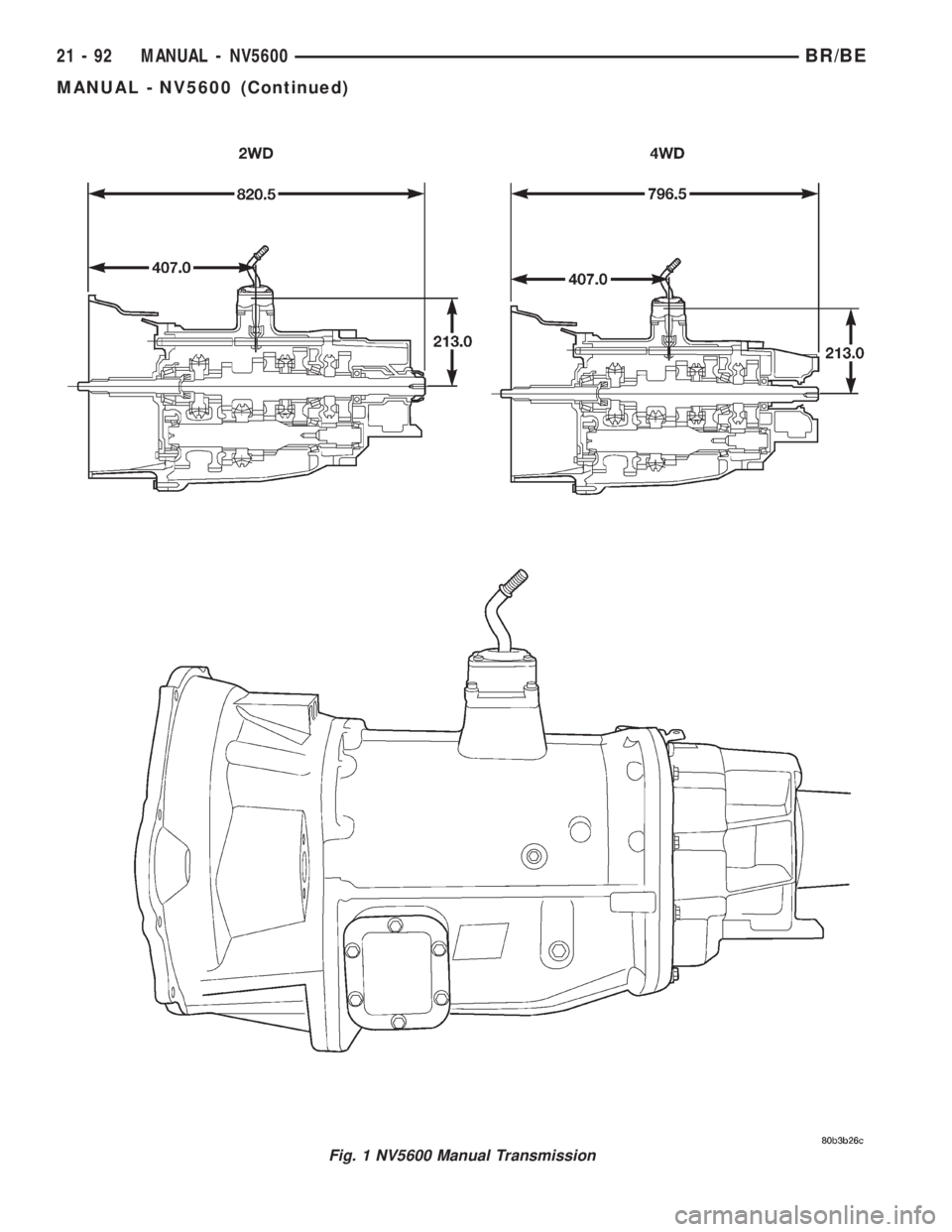
Fig. 1 NV5600 Manual Transmission
21 - 92 MANUAL - NV5600BR/BE
MANUAL - NV5600 (Continued)
Page 1728 of 2889
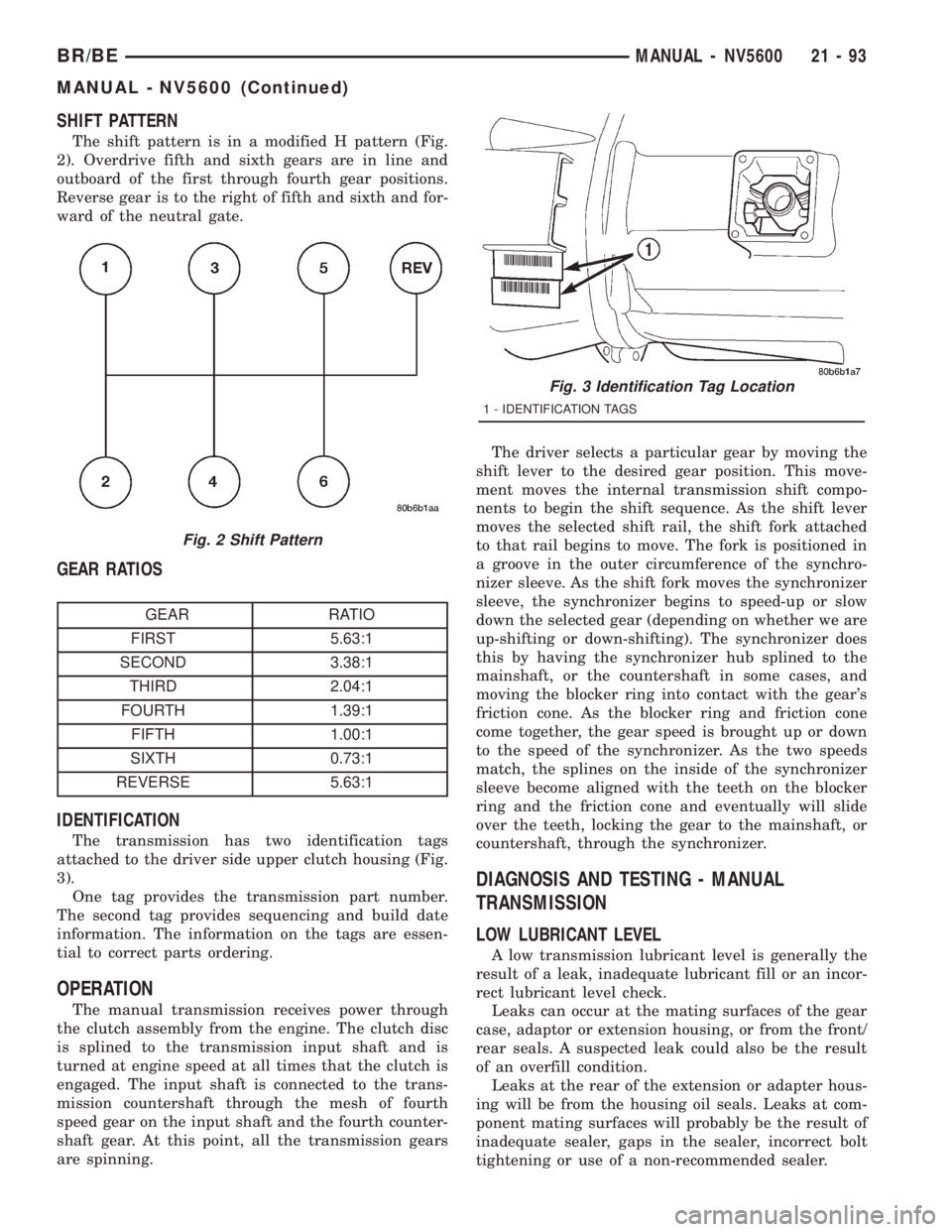
SHIFT PATTERN
The shift pattern is in a modified H pattern (Fig.
2). Overdrive fifth and sixth gears are in line and
outboard of the first through fourth gear positions.
Reverse gear is to the right of fifth and sixth and for-
ward of the neutral gate.
GEAR RATIOS
GEAR RATIO
FIRST 5.63:1
SECOND 3.38:1
THIRD 2.04:1
FOURTH 1.39:1
FIFTH 1.00:1
SIXTH 0.73:1
REVERSE 5.63:1
IDENTIFICATION
The transmission has two identification tags
attached to the driver side upper clutch housing (Fig.
3).
One tag provides the transmission part number.
The second tag provides sequencing and build date
information. The information on the tags are essen-
tial to correct parts ordering.
OPERATION
The manual transmission receives power through
the clutch assembly from the engine. The clutch disc
is splined to the transmission input shaft and is
turned at engine speed at all times that the clutch is
engaged. The input shaft is connected to the trans-
mission countershaft through the mesh of fourth
speed gear on the input shaft and the fourth counter-
shaft gear. At this point, all the transmission gears
are spinning.The driver selects a particular gear by moving the
shift lever to the desired gear position. This move-
ment moves the internal transmission shift compo-
nents to begin the shift sequence. As the shift lever
moves the selected shift rail, the shift fork attached
to that rail begins to move. The fork is positioned in
a groove in the outer circumference of the synchro-
nizer sleeve. As the shift fork moves the synchronizer
sleeve, the synchronizer begins to speed-up or slow
down the selected gear (depending on whether we are
up-shifting or down-shifting). The synchronizer does
this by having the synchronizer hub splined to the
mainshaft, or the countershaft in some cases, and
moving the blocker ring into contact with the gear's
friction cone. As the blocker ring and friction cone
come together, the gear speed is brought up or down
to the speed of the synchronizer. As the two speeds
match, the splines on the inside of the synchronizer
sleeve become aligned with the teeth on the blocker
ring and the friction cone and eventually will slide
over the teeth, locking the gear to the mainshaft, or
countershaft, through the synchronizer.
DIAGNOSIS AND TESTING - MANUAL
TRANSMISSION
LOW LUBRICANT LEVEL
A low transmission lubricant level is generally the
result of a leak, inadequate lubricant fill or an incor-
rect lubricant level check.
Leaks can occur at the mating surfaces of the gear
case, adaptor or extension housing, or from the front/
rear seals. A suspected leak could also be the result
of an overfill condition.
Leaks at the rear of the extension or adapter hous-
ing will be from the housing oil seals. Leaks at com-
ponent mating surfaces will probably be the result of
inadequate sealer, gaps in the sealer, incorrect bolt
tightening or use of a non-recommended sealer.
Fig. 2 Shift Pattern
Fig. 3 Identification Tag Location
1 - IDENTIFICATION TAGS
BR/BEMANUAL - NV5600 21 - 93
MANUAL - NV5600 (Continued)
Page 1729 of 2889
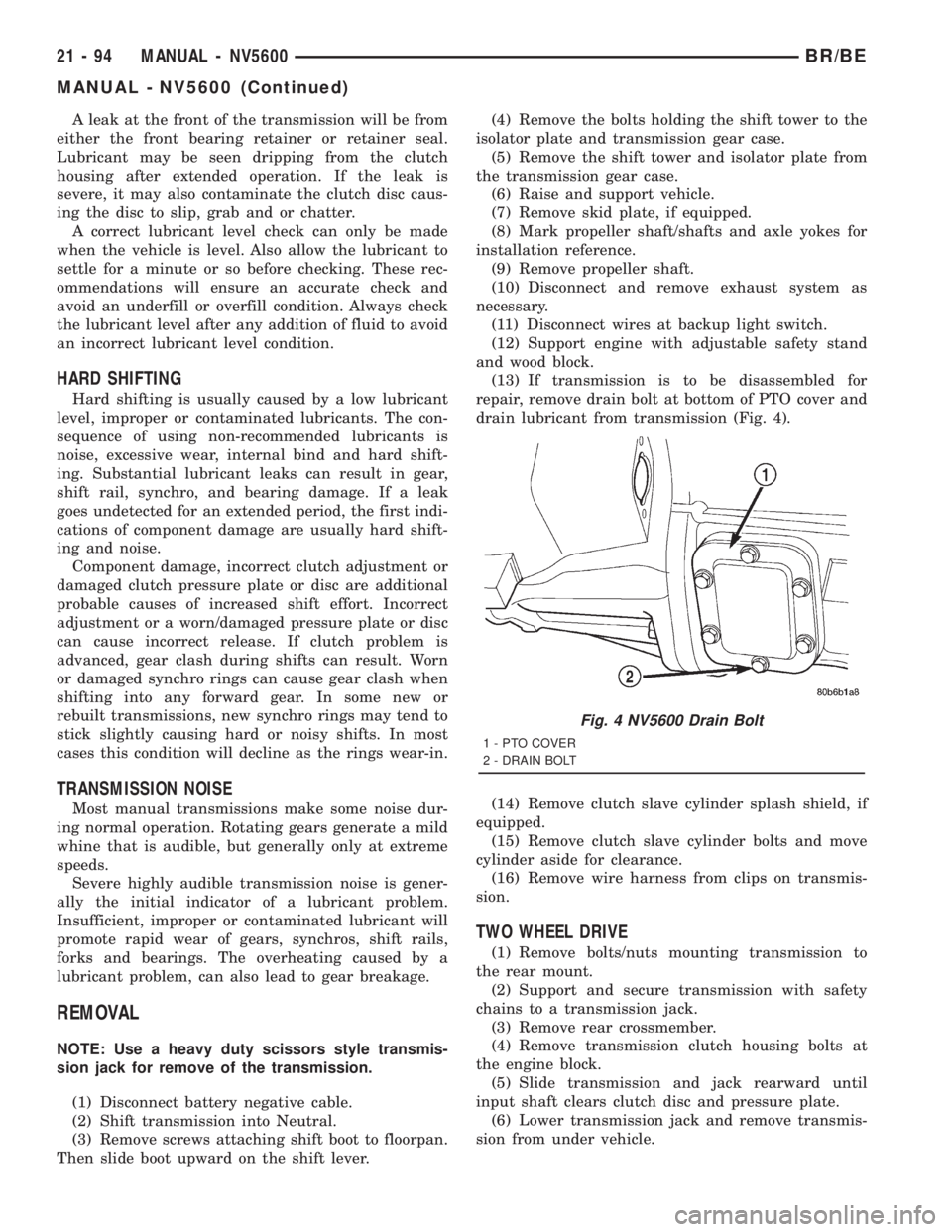
A leak at the front of the transmission will be from
either the front bearing retainer or retainer seal.
Lubricant may be seen dripping from the clutch
housing after extended operation. If the leak is
severe, it may also contaminate the clutch disc caus-
ing the disc to slip, grab and or chatter.
A correct lubricant level check can only be made
when the vehicle is level. Also allow the lubricant to
settle for a minute or so before checking. These rec-
ommendations will ensure an accurate check and
avoid an underfill or overfill condition. Always check
the lubricant level after any addition of fluid to avoid
an incorrect lubricant level condition.
HARD SHIFTING
Hard shifting is usually caused by a low lubricant
level, improper or contaminated lubricants. The con-
sequence of using non-recommended lubricants is
noise, excessive wear, internal bind and hard shift-
ing. Substantial lubricant leaks can result in gear,
shift rail, synchro, and bearing damage. If a leak
goes undetected for an extended period, the first indi-
cations of component damage are usually hard shift-
ing and noise.
Component damage, incorrect clutch adjustment or
damaged clutch pressure plate or disc are additional
probable causes of increased shift effort. Incorrect
adjustment or a worn/damaged pressure plate or disc
can cause incorrect release. If clutch problem is
advanced, gear clash during shifts can result. Worn
or damaged synchro rings can cause gear clash when
shifting into any forward gear. In some new or
rebuilt transmissions, new synchro rings may tend to
stick slightly causing hard or noisy shifts. In most
cases this condition will decline as the rings wear-in.
TRANSMISSION NOISE
Most manual transmissions make some noise dur-
ing normal operation. Rotating gears generate a mild
whine that is audible, but generally only at extreme
speeds.
Severe highly audible transmission noise is gener-
ally the initial indicator of a lubricant problem.
Insufficient, improper or contaminated lubricant will
promote rapid wear of gears, synchros, shift rails,
forks and bearings. The overheating caused by a
lubricant problem, can also lead to gear breakage.
REMOVAL
NOTE: Use a heavy duty scissors style transmis-
sion jack for remove of the transmission.
(1) Disconnect battery negative cable.
(2) Shift transmission into Neutral.
(3) Remove screws attaching shift boot to floorpan.
Then slide boot upward on the shift lever.(4) Remove the bolts holding the shift tower to the
isolator plate and transmission gear case.
(5) Remove the shift tower and isolator plate from
the transmission gear case.
(6) Raise and support vehicle.
(7) Remove skid plate, if equipped.
(8) Mark propeller shaft/shafts and axle yokes for
installation reference.
(9) Remove propeller shaft.
(10) Disconnect and remove exhaust system as
necessary.
(11) Disconnect wires at backup light switch.
(12) Support engine with adjustable safety stand
and wood block.
(13) If transmission is to be disassembled for
repair, remove drain bolt at bottom of PTO cover and
drain lubricant from transmission (Fig. 4).
(14) Remove clutch slave cylinder splash shield, if
equipped.
(15) Remove clutch slave cylinder bolts and move
cylinder aside for clearance.
(16) Remove wire harness from clips on transmis-
sion.
TWO WHEEL DRIVE
(1) Remove bolts/nuts mounting transmission to
the rear mount.
(2) Support and secure transmission with safety
chains to a transmission jack.
(3) Remove rear crossmember.
(4) Remove transmission clutch housing bolts at
the engine block.
(5) Slide transmission and jack rearward until
input shaft clears clutch disc and pressure plate.
(6) Lower transmission jack and remove transmis-
sion from under vehicle.
Fig. 4 NV5600 Drain Bolt
1 - PTO COVER
2 - DRAIN BOLT
21 - 94 MANUAL - NV5600BR/BE
MANUAL - NV5600 (Continued)
Page 1730 of 2889
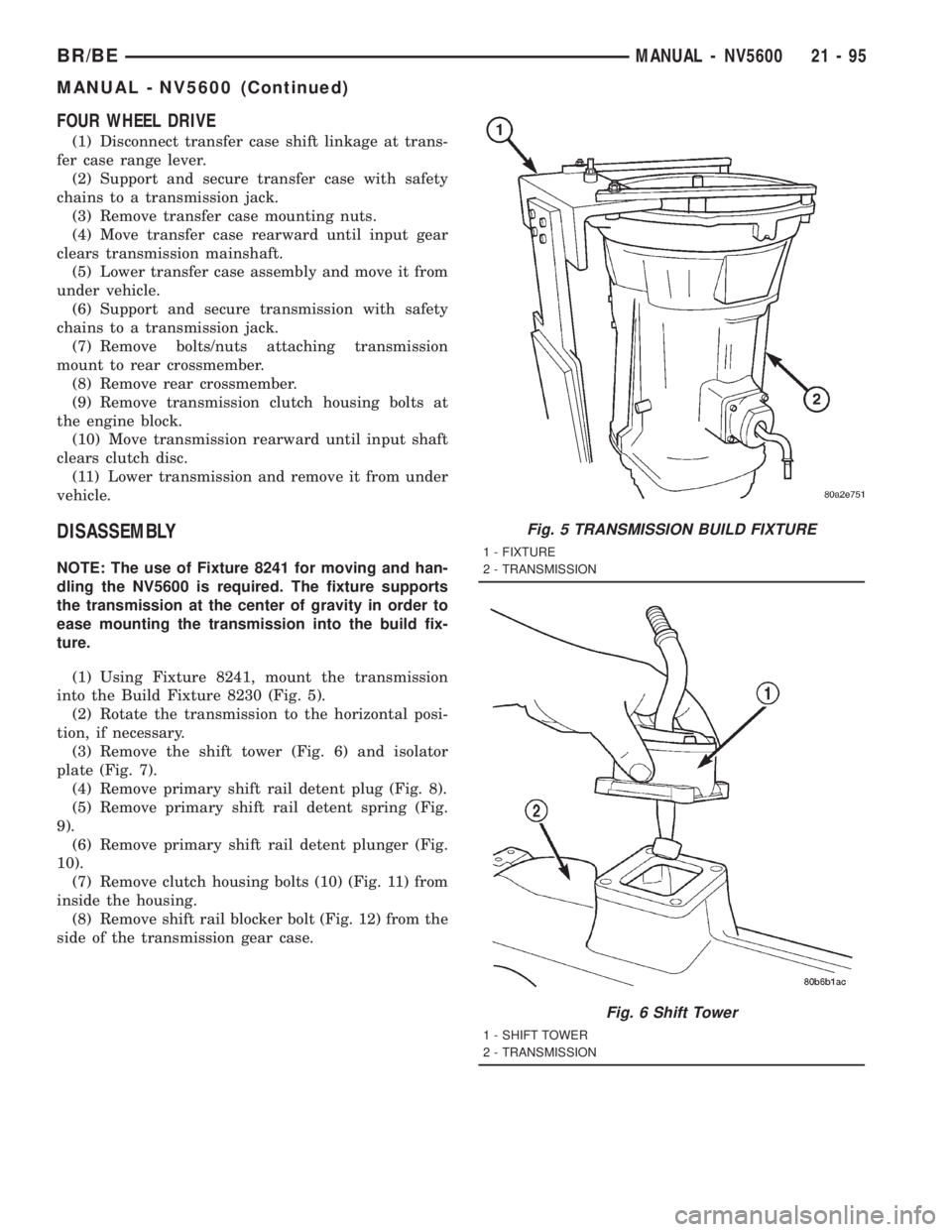
FOUR WHEEL DRIVE
(1) Disconnect transfer case shift linkage at trans-
fer case range lever.
(2) Support and secure transfer case with safety
chains to a transmission jack.
(3) Remove transfer case mounting nuts.
(4) Move transfer case rearward until input gear
clears transmission mainshaft.
(5) Lower transfer case assembly and move it from
under vehicle.
(6) Support and secure transmission with safety
chains to a transmission jack.
(7) Remove bolts/nuts attaching transmission
mount to rear crossmember.
(8) Remove rear crossmember.
(9) Remove transmission clutch housing bolts at
the engine block.
(10) Move transmission rearward until input shaft
clears clutch disc.
(11) Lower transmission and remove it from under
vehicle.
DISASSEMBLY
NOTE: The use of Fixture 8241 for moving and han-
dling the NV5600 is required. The fixture supports
the transmission at the center of gravity in order to
ease mounting the transmission into the build fix-
ture.
(1) Using Fixture 8241, mount the transmission
into the Build Fixture 8230 (Fig. 5).
(2) Rotate the transmission to the horizontal posi-
tion, if necessary.
(3) Remove the shift tower (Fig. 6) and isolator
plate (Fig. 7).
(4) Remove primary shift rail detent plug (Fig. 8).
(5) Remove primary shift rail detent spring (Fig.
9).
(6) Remove primary shift rail detent plunger (Fig.
10).
(7) Remove clutch housing bolts (10) (Fig. 11) from
inside the housing.
(8) Remove shift rail blocker bolt (Fig. 12) from the
side of the transmission gear case.
Fig. 5 TRANSMISSION BUILD FIXTURE
1 - FIXTURE
2 - TRANSMISSION
Fig. 6 Shift Tower
1 - SHIFT TOWER
2 - TRANSMISSION
BR/BEMANUAL - NV5600 21 - 95
MANUAL - NV5600 (Continued)